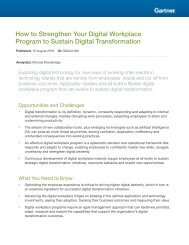The_Future_of_Employment
You also want an ePaper? Increase the reach of your titles
YUMPU automatically turns print PDFs into web optimized ePapers that Google loves.
Titles (DOT), last revised in 1991, we rely on the 2010 version <strong>of</strong> the DOT successor<br />
O∗NET – an online service developed for the US Department <strong>of</strong> Labor. 4<br />
Accordingly, O∗NET has the advantage <strong>of</strong> providing more recent information<br />
on occupational work activities.<br />
Second, our study relates to the literature examining the <strong>of</strong>fshoring <strong>of</strong> information-based<br />
tasks to foreign worksites (Jensen and Kletzer, 2005; Blinder,<br />
2009; Jensen and Kletzer, 2010; Oldenski, 2012; Blinder and Krueger, 2013).<br />
This literature consists <strong>of</strong> different methodologies to rank and categorise occupations<br />
according to their susceptibility to <strong>of</strong>fshoring. For example, using<br />
O∗NET data on the nature <strong>of</strong> work done in different occupations, Blinder (2009)<br />
estimates that 22 to 29 percent <strong>of</strong> US jobs are or will be <strong>of</strong>fshorable in the next<br />
decade or two. <strong>The</strong>se estimates are based on two defining characteristics <strong>of</strong> jobs<br />
that cannot be <strong>of</strong>fshored: (a) the job must be performed at a specific work location;<br />
and (b) the job requires face-to-face personal communication. Naturally,<br />
the characteristics <strong>of</strong> occupations that can be <strong>of</strong>fshored are different from the<br />
characteristics <strong>of</strong> occupations that can be automated. For example, the work <strong>of</strong><br />
cashiers, which has largely been substituted by self- service technology, must<br />
be performed at specific work location and requires face-to-face contact. <strong>The</strong><br />
extent <strong>of</strong> computerisation is therefore likely to go beyond that <strong>of</strong> <strong>of</strong>fshoring.<br />
Hence, while the implementation <strong>of</strong> our methodology is similar to that <strong>of</strong> Blinder<br />
(2009), we rely on different occupational characteristics.<br />
<strong>The</strong> remainder <strong>of</strong> this paper is structured as follows. In Section II, we review<br />
the literature on the historical relationship between technological progress and<br />
employment. Section III describes recent and expected future technological<br />
developments. In Section IV, we describe our methodology, and in Section V,<br />
we examine the expected impact <strong>of</strong> these technological developments on labour<br />
market outcomes. Finally, in Section VI, we derive some conclusions.<br />
II.<br />
A HISTORY OF TECHNOLOGICAL REVOLUTIONS AND EMPLOYMENT<br />
<strong>The</strong> concern over technological unemployment is hardly a recent phenomenon.<br />
Throughout history, the process <strong>of</strong> creative destruction, following technological<br />
inventions, has created enormous wealth, but also undesired disruptions.<br />
As stressed by Schumpeter (1962), it was not the lack <strong>of</strong> inventive ideas that<br />
4 An exception is Goos, et al. (2009).<br />
5





